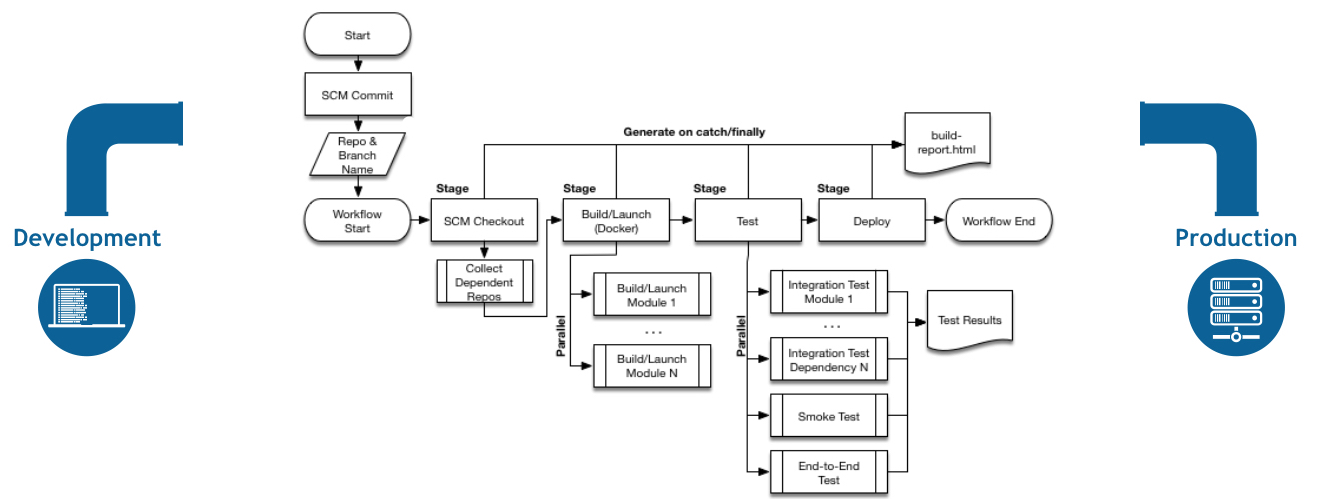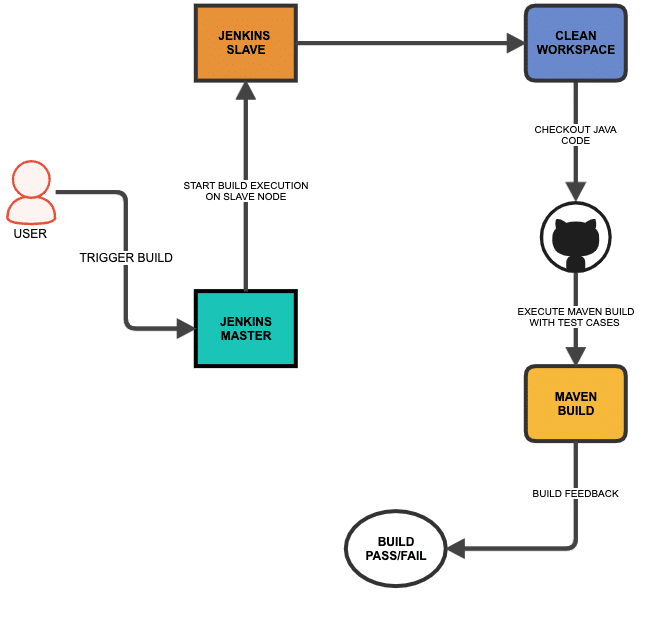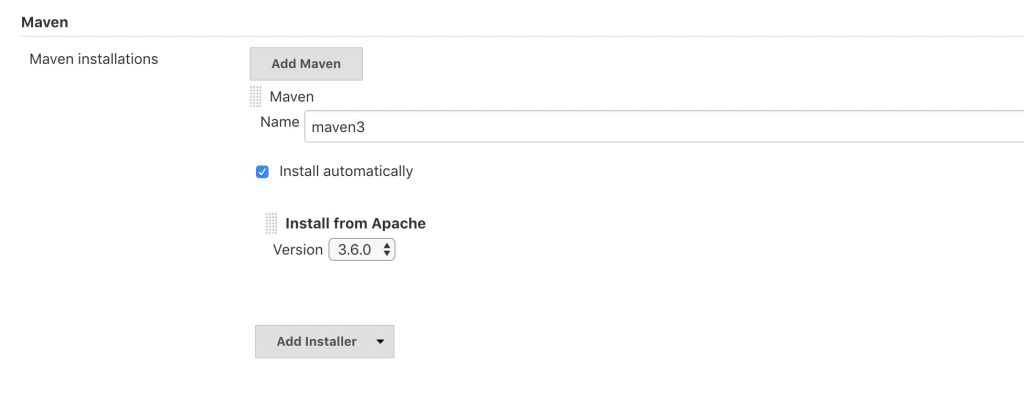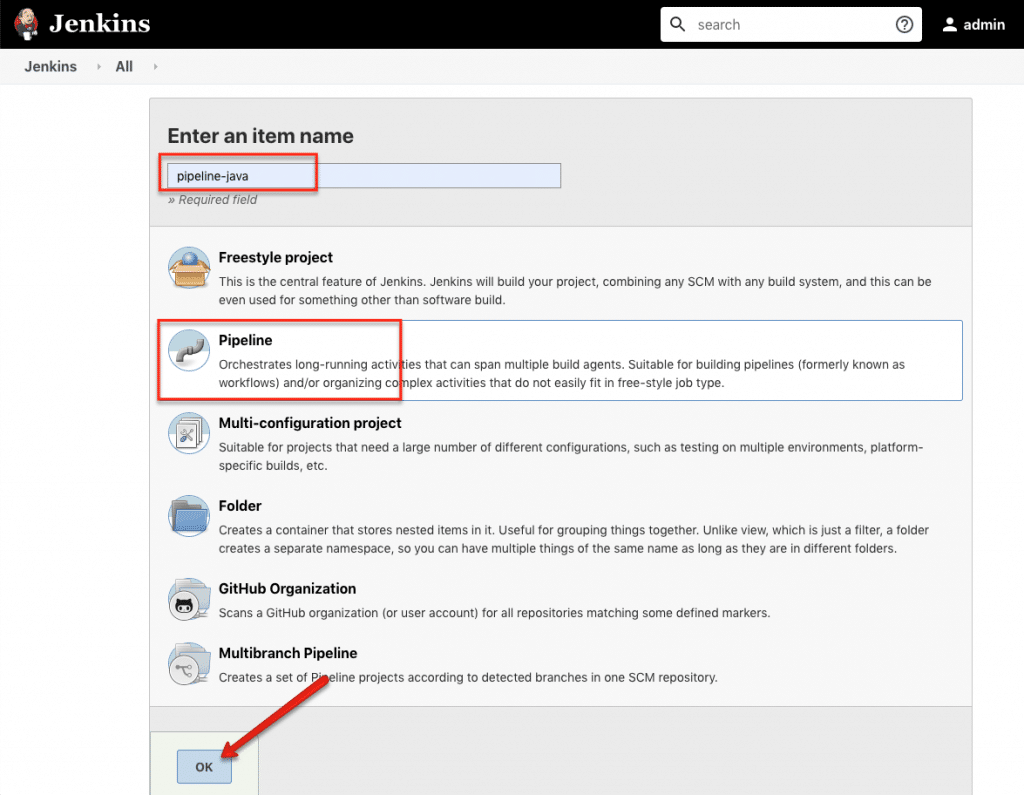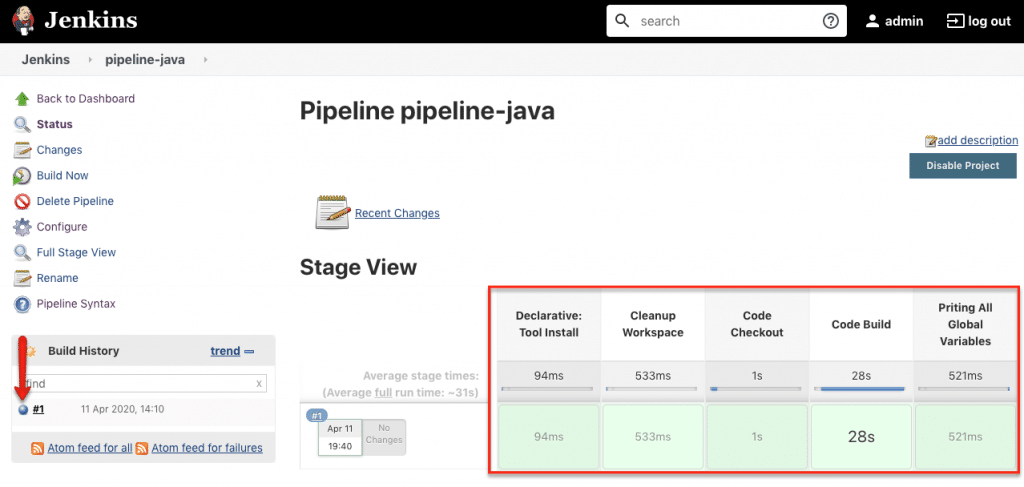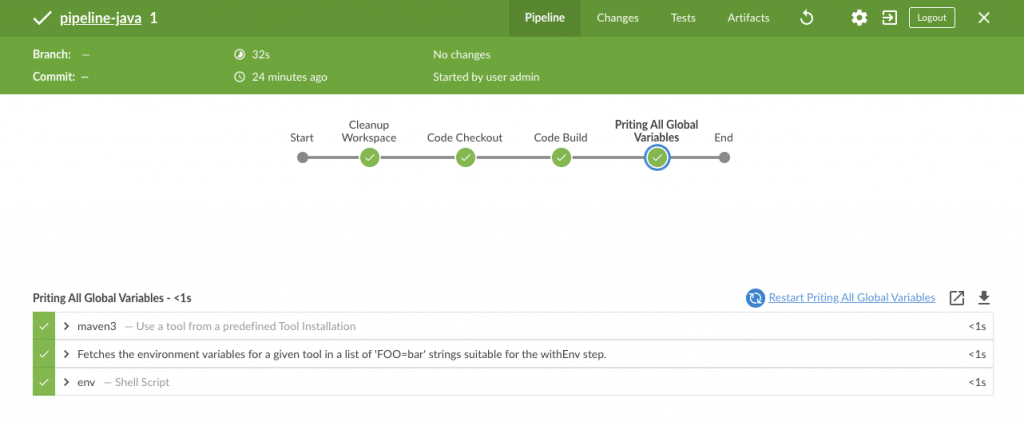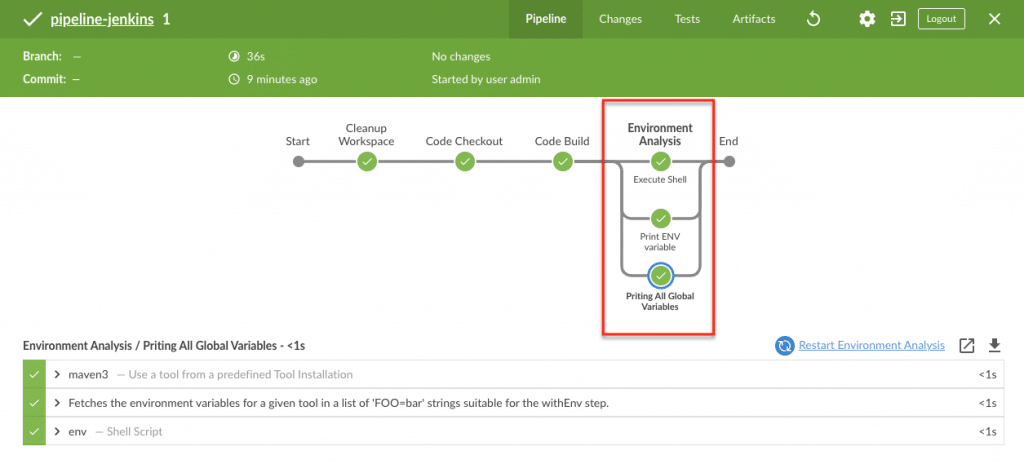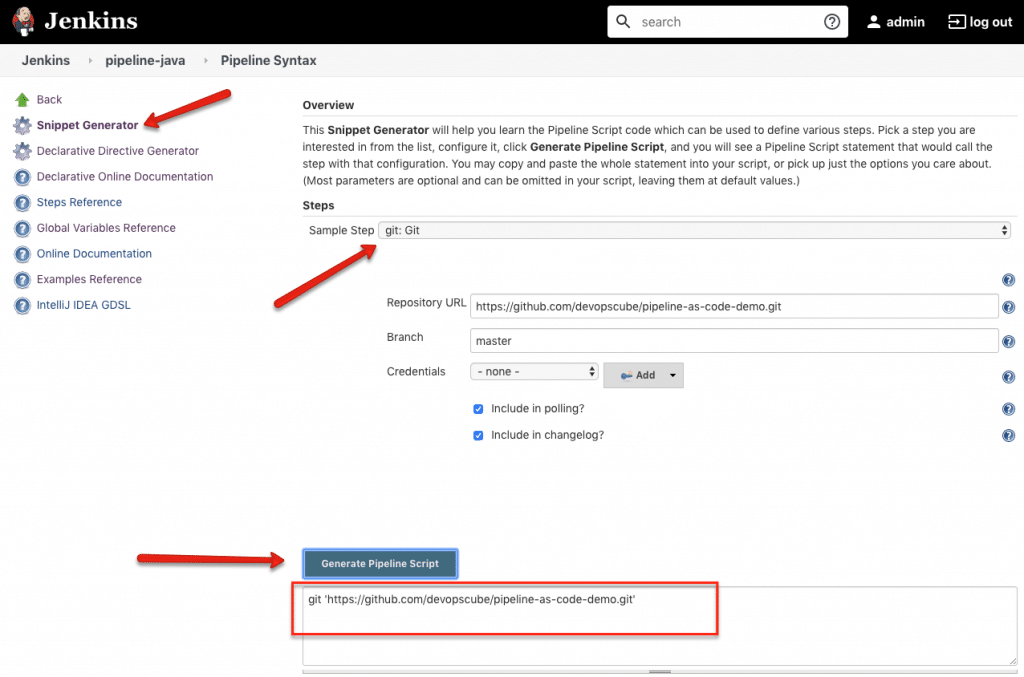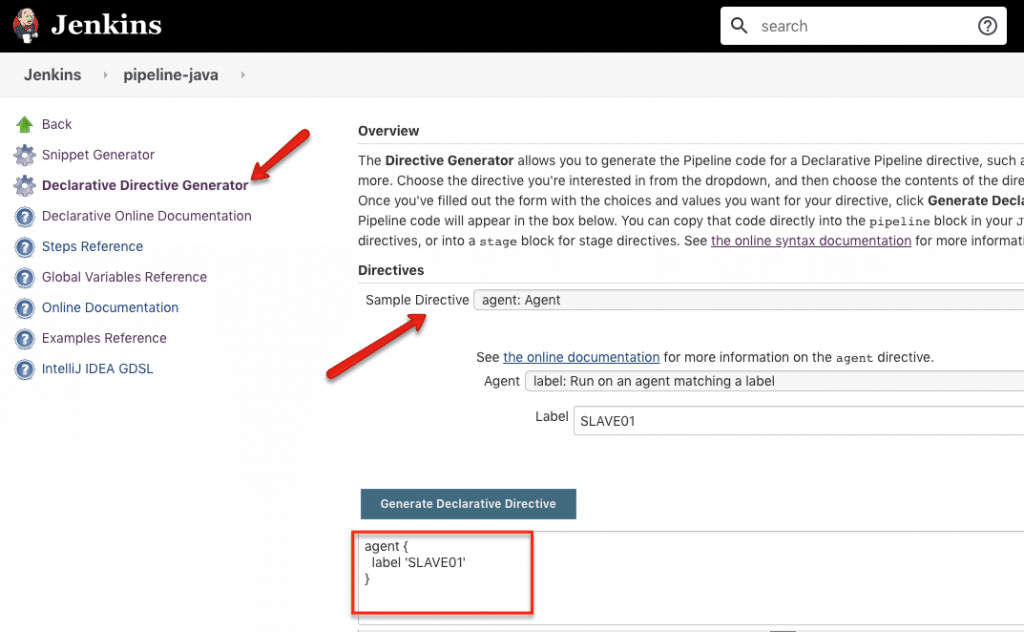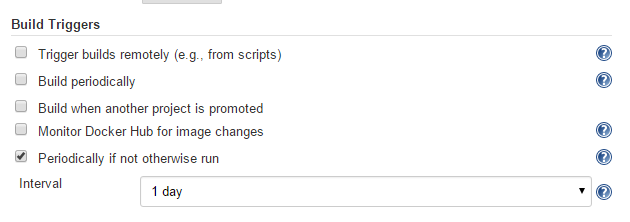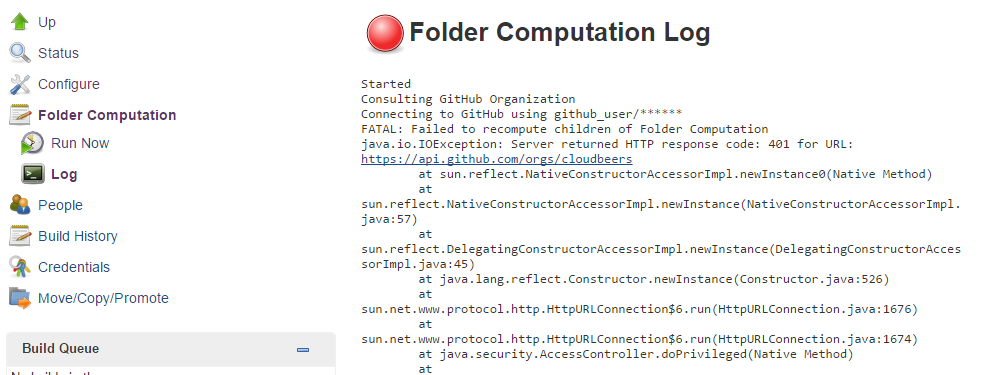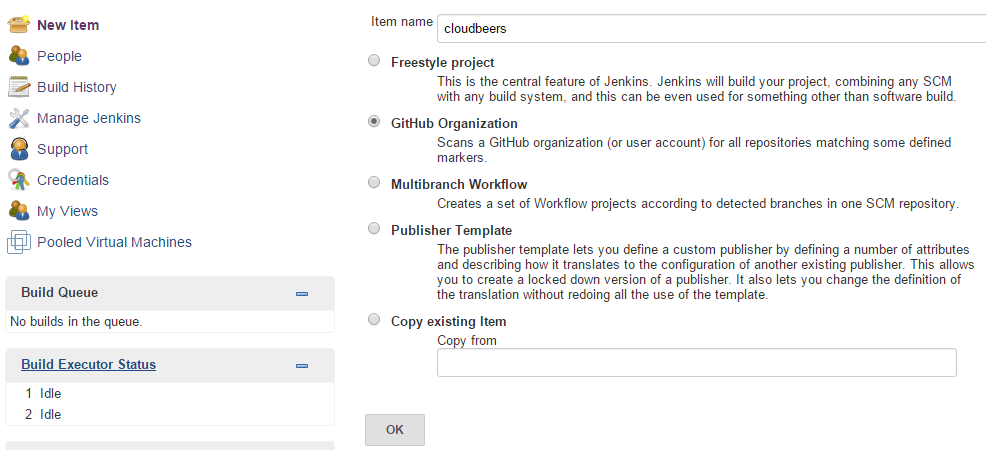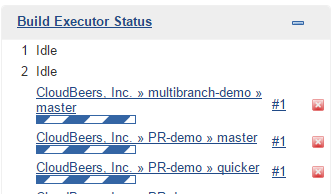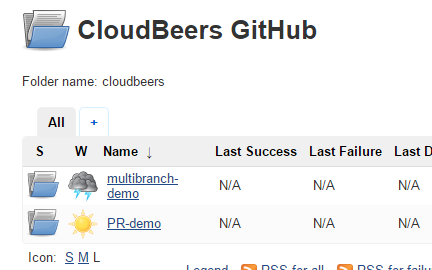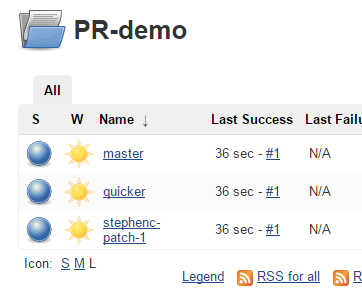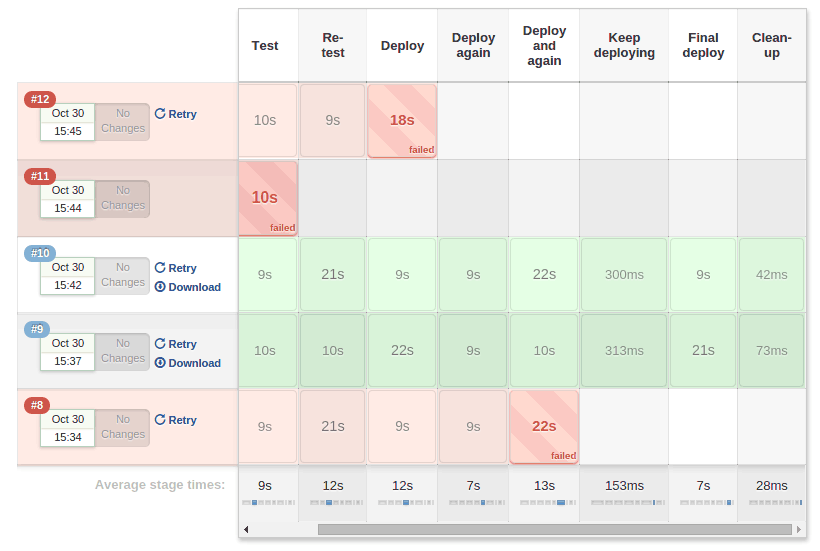какие типы pipeline as code есть в jenkins
Pipeline
This chapter covers all recommended aspects of Jenkins Pipeline functionality, including how to:
use different development tools to facilitate the creation of your Pipeline, and
For an overview of content in the Jenkins User Handbook, see User Handbook overview.
What is Jenkins Pipeline?
Jenkins Pipeline (or simply «Pipeline» with a capital «P») is a suite of plugins which supports implementing and integrating continuous delivery pipelines into Jenkins.
A continuous delivery (CD) pipeline is an automated expression of your process for getting software from version control right through to your users and customers. Every change to your software (committed in source control) goes through a complex process on its way to being released. This process involves building the software in a reliable and repeatable manner, as well as progressing the built software (called a «build») through multiple stages of testing and deployment.
Pipeline provides an extensible set of tools for modeling simple-to-complex delivery pipelines «as code» via the Pipeline domain-specific language (DSL) syntax. [1]
The definition of a Jenkins Pipeline is written into a text file (called a Jenkinsfile ) which in turn can be committed to a project’s source control repository. [2] This is the foundation of «Pipeline-as-code»; treating the CD pipeline a part of the application to be versioned and reviewed like any other code.
Creating a Jenkinsfile and committing it to source control provides a number of immediate benefits:
Automatically creates a Pipeline build process for all branches and pull requests.
Code review/iteration on the Pipeline (along with the remaining source code).
Audit trail for the Pipeline.
Single source of truth [3] for the Pipeline, which can be viewed and edited by multiple members of the project.
While the syntax for defining a Pipeline, either in the web UI or with a Jenkinsfile is the same, it is generally considered best practice to define the Pipeline in a Jenkinsfile and check that in to source control.
Declarative versus Scripted Pipeline syntax
Declarative and Scripted Pipelines are constructed fundamentally differently. Declarative Pipeline is a more recent feature of Jenkins Pipeline which:
provides richer syntactical features over Scripted Pipeline syntax, and
is designed to make writing and reading Pipeline code easier.
Why Pipeline?
Jenkins is, fundamentally, an automation engine which supports a number of automation patterns. Pipeline adds a powerful set of automation tools onto Jenkins, supporting use cases that span from simple continuous integration to comprehensive CD pipelines. By modeling a series of related tasks, users can take advantage of the many features of Pipeline:
Code: Pipelines are implemented in code and typically checked into source control, giving teams the ability to edit, review, and iterate upon their delivery pipeline.
Durable: Pipelines can survive both planned and unplanned restarts of the Jenkins controller.
Pausable: Pipelines can optionally stop and wait for human input or approval before continuing the Pipeline run.
Versatile: Pipelines support complex real-world CD requirements, including the ability to fork/join, loop, and perform work in parallel.
Extensible: The Pipeline plugin supports custom extensions to its DSL [1] and multiple options for integration with other plugins.
While Jenkins has always allowed rudimentary forms of chaining Freestyle Jobs together to perform sequential tasks, [4] Pipeline makes this concept a first-class citizen in Jenkins.
Building on the core Jenkins value of extensibility, Pipeline is also extensible both by users with Pipeline Shared Libraries and by plugin developers. [5]
The flowchart below is an example of one CD scenario easily modeled in Jenkins Pipeline:
Pipeline concepts
The following concepts are key aspects of Jenkins Pipeline, which tie in closely to Pipeline syntax (see the overview below).
Pipeline
A Pipeline is a user-defined model of a CD pipeline. A Pipeline’s code defines your entire build process, which typically includes stages for building an application, testing it and then delivering it.
A node is a machine which is part of the Jenkins environment and is capable of executing a Pipeline.
Stage
A stage block defines a conceptually distinct subset of tasks performed through the entire Pipeline (e.g. «Build», «Test» and «Deploy» stages), which is used by many plugins to visualize or present Jenkins Pipeline status/progress. [6]
Pipeline syntax overview
The following Pipeline code skeletons illustrate the fundamental differences between Declarative Pipeline syntax and Scripted Pipeline syntax.
Be aware that both stages and steps (above) are common elements of both Declarative and Scripted Pipeline syntax.
Declarative Pipeline fundamentals
In Declarative Pipeline syntax, the pipeline block defines all the work done throughout your entire Pipeline.
| Execute this Pipeline or any of its stages, on any available agent. |
| Defines the «Build» stage. |
| Perform some steps related to the «Build» stage. |
| Defines the «Test» stage. |
| Perform some steps related to the «Test» stage. |
| Defines the «Deploy» stage. |
| Perform some steps related to the «Deploy» stage. |
Scripted Pipeline fundamentals
In Scripted Pipeline syntax, one or more node blocks do the core work throughout the entire Pipeline. Although this is not a mandatory requirement of Scripted Pipeline syntax, confining your Pipeline’s work inside of a node block does two things:
Schedules the steps contained within the block to run by adding an item to the Jenkins queue. As soon as an executor is free on a node, the steps will run.
Creates a workspace (a directory specific to that particular Pipeline) where work can be done on files checked out from source control.
Caution: Depending on your Jenkins configuration, some workspaces may not get automatically cleaned up after a period of inactivity. See tickets and discussion linked from JENKINS-2111 for more information.
| Execute this Pipeline or any of its stages, on any available agent. |
| Defines the «Build» stage. stage blocks are optional in Scripted Pipeline syntax. However, implementing stage blocks in a Scripted Pipeline provides clearer visualization of each `stage’s subset of tasks/steps in the Jenkins UI. |
| Perform some steps related to the «Build» stage. |
| Defines the «Test» stage. |
| Perform some steps related to the «Test» stage. |
| Defines the «Deploy» stage. |
| Perform some steps related to the «Deploy» stage. |
Pipeline example
Read more about Pipeline syntax on the Pipeline Syntax page.
Jenkins Pipeline Tutorial For Beginners
Jenkins pipeline as code is a concept of defining Jenkins build pipeline in Jenkins DSL/Groovy format. This article covers the key concepts involved in writing Jenkins pipeline as code using declarative syntax.
Jenkins Pipeline Tutorial
In this Jenkins pipeline tutorial, we will look at the following
Types of Jenkins Pipeline
There are two types of Jenkins pipeline code.
In this tutorial, we will focus only on the declarative syntax as it is an advanced version of the scripted pipeline with extensible features. Also, I recommend using the declarative pipeline approach for all your Jenkins use cases. There are a lot of features and benefits you will get from the declarative pipeline approach.
You can check out my article on Jenkins’s multibranch pipeline which uses declarative pipeline as code with Jenkinsfile approach.
Now let’s get started with the pipeline tutorial.
For better understanding, we will create a pipeline for the Java Spring Boot application build using the declarative pipeline as code.
Prerequisites
Here us the pictorial representation of the simple build pipeline we are going to build.
Here is the pipeline code for the above workflow. Before setting up the pipeline we will understand what each block means.
Note: Do not worry about the DSL used in the pipeline code. Read the article fully to understand how to generate the DSLs in an easy way.
Now lets understand what each block means.
Now that we have a basic understanding of a minimal pipeline as code, lets practically execute this pipeline on a Jenkins server with a slave node.
Configure Pipeline as Code Job In Jenkins
To execute the pipeline code we have in this article, we need to configure maven in global tool configuration.
Go to Manage Jenkins –> Global Tool Configuration –> Maven –> Maven Installation.
Add a maven configuration as shown below. We are using the tool name as maven3 in the pipeline, so that it refers to the maven under “Global Tool Configuration”.
Note: We have selected “Install Automatically” option, which will download the selected version every time you execute the job.
Creating & Building a Jenkins Pipeline Job
Follow the steps given below to create and build our pipeline as code.
Step 1: Go to Jenkins home and select “New Item”
Step 2: Give a name, select “Pipeline” and click ok.
Step 3: Scroll down to the Pipeline section, copy the whole pipeline code in the script section and save it.
Step 4: Now, click “Build Now” and wait for the build to start.
While the job starts you can view each stage executing in stage view. Here is the screenshot of a successfully executed job. Also, you can the job logs by clicking the blue icon.
If you have the blue ocean plugin installed, you can have a very good UI to view your job status and logs as shown below. Use the “Open in Blue Ocean” from the left to open a job in the blue ocean view.
Executing Jenkins Pipeline From Github (Jenkinsfile)
In the last section, we used the pipeline script directly on Jenkins. In this section, we will look at how to execute a pipeline script available in an SCM system like Github.
Step 2: Follow the same steps we used for creating a pipeline job. But instead of entering the code directly into the script block, select the “Pipeline script from SCM” option and fill in the details as shown below.
Step 3: Save the configuration and run the build. You should see a successful build.
Executing Jenkins Pipeline Stages In Parallel
There are use cases where you have to execute different stages in parallel because each stage will be independent and does not depend on other steps. Also, running separate stages in parallel will reduce the build times as well.
You can achieve parallelism in Jenkins pipelines as code using the parallel block.
Here is an example stage that contains three parallel stages. It’s like you will have multiple stages inside a stage. You can test this by adding the following code to your existing pipeline.
You can clearly see the parallel execution on blue ocean view.
How to Generate Jenkins Pipeline Scripts?
It is possible to generate Jenkins pipeline scripts?
Yes! you can generate most of the pipeline scripts from Jenkins. Here is how it works.
Jenkins has its own pipeline script generator. You can access the generator on /pipeline-syntax path.
You can also get the syntax generator path from your pipeline job configuration as shown below.
Snippet Generator
Snippet generator is used for generating all the scripts that are using inside the stages.
Here is how the generator looks. You can select the required option from the steps dropdown, fill in the required details and generate the script to use in your pipeline.
Declarative Directive Generator
You can use the directive generator to generate all other options in the pipeline. For example, options, parameters, triggers, etc.
Here is an example of generating the agent block.
Conclusion
Adopting pipeline code for all Jenkins workflows will give more control and streamlined pipelines for your CI/CD need. Extending your pipelines with a shared library lets you reuse the pipeline code for all implementations. Let us know your thoughts in the comment section below.
Pipeline as Code
Pipeline as Code
Introduction
Pipeline as Code describes a set of features that allow Jenkins users to define pipelined job processes with code, stored and versioned in a source repository. These features allow Jenkins to discover, manage, and run jobs for multiple source repositories and branches — eliminating the need for manual job creation and management.
To use Pipeline as Code, projects must contain a file named Jenkinsfile in the repository root, which contains a «Pipeline script.»
Additionally, one of the enabling jobs needs to be configured in Jenkins:
Multibranch Pipeline: build multiple branches of a single repository automatically
Organization Folders: scan a GitHub Organization or Bitbucket Team to discover an organization’s repositories, automatically creating managed Multibranch Pipeline jobs for them
Pipeline: Regular Pipeline jobs have an option when specifying the pipeline to «Use SCM».
Fundamentally, an organization’s repositories can be viewed as a hierarchy, where each repository may have child elements of branches and pull requests.
Multibranch Pipeline and Organization Folders eliminate the manual process by detecting branches and repositories, respectively, and creating appropriate folders with jobs in Jenkins automatically.
The Jenkinsfile
Presence of the Jenkinsfile in the root of a repository makes it eligible for Jenkins to automatically manage and execute jobs based on repository branches.
The Jenkinsfile should contain a Pipeline script, specifying the steps to execute the job. The script has all the power of Pipeline available, from something as simple as invoking a Maven builder, to a series of interdependent steps, which have coordinated parallel execution with deployment and validation phases.
A simple way to get started with Pipeline is to use the Snippet Generator available in the configuration screen for a Jenkins Pipeline job. Using the Snippet Generator, you can create a Pipeline script as you might through the dropdowns in other Jenkins jobs.
Folder Computation
Multibranch Pipeline projects and Organization Folders extend the existing folder functionality by introducing ‘computed’ folders. Computed folders automatically run a process to manage the folder contents. This computation, in the case of Multibranch Pipeline projects, creates child items for each eligible branch within the child. For Organization Folders, computation populates child items for repositories as individual Multibranch Pipelines.
Folder computation may happen automatically via webhook callbacks, as branches and repositories are created or removed. Computation may also be triggered by the Build Trigger defined in the configuration, which will automatically run a computation task after a period of inactivity (this defaults to run after one day).
Information about the last execution of the folder computation is available in the Folder Computation section.
The log from the last attempt to compute the folder is available from this page. If folder computation doesn’t result in an expected set of repositories, the log may have useful information to diagnose the problem.
Configuration
Both Multibranch Pipeline projects and Organization Folders have configuration options to allow precise selection of repositories. These features also allow selection of two types of credentails to use when connecting to the remote systems:
scan credentials, which are used for accessing the GitHub or Bitbucket APIs
| If you are using a GitHub Organization, you should create a GitHub access token to use to avoid storing your password in Jenkins and prevent any issues when using the GitHub API. When using a GitHub access token, you must use standard Username with password credentials, where the username is the same as your GitHub username and the password is your access token. |
Multibranch Pipeline Projects
Multibranch Pipeline projects are one of the fundamental enabling features for Pipeline as Code. Changes to the build or deployment procedure can evolve with project requirements and the job always reflects the current state of the project. It also allows you to configure different jobs for different branches of the same project, or to forgo a job if appropriate. The Jenkinsfile in the root directory of a branch or pull request identifies a multibranch project.
To create a Multibranch Pipeline, go to: New Item → Multibranch Pipeline. Configure the SCM source as appropriate. There are options for many different types of repositories and services including Git, Mercurial, Bitbucket, and GitHub. If using GitHub, for example, click Add source, select GitHub and configure the appropriate owner, scan credentials, and repository.
Other options available to Multibranch Pipeline projects are:
After configuring these items and saving the configuration, Jenkins will automatically scan the repository and import appropriate branches.
Organization Folders
To create an Organization Folder in Jenkins, go to: New Item → GitHub Organization or New Item → Bitbucket Team and follow the configuration steps for each item, making sure to specify appropriate Scan Credentials and a specific owner for the GitHub Organization or Bitbucket Team name, respectively.
Other options available are:
After configuring these items and saving the configuration, Jenkins will automatically scan the organization and import appropriate repositories and resulting branches.
Orphaned Item Strategy
Computed folders can remove items immediately or leave them based on a desired retention strategy. By default, items will be removed as soon as the folder computation determines they are no longer present. If your organization requires these items remain available for a longer period of time, simply configure the Orphaned Item Strategy appropriately. It may be useful to keep items in order to examine build results of a branch after it’s been removed, for example.
Icon and View Strategy
You may also configure an icon to use for the folder display. For example, it might be useful to display an aggregate health of the child builds. Alternately, you might reference the same icon you use in your GitHub organization account.
Example
To demonstrate using an Organization Folder to manage repositories, we’ll use the fictitious organization: CloudBeers, Inc..
Go to New Item. Enter ‘cloudbeers’ for the item name. Select GitHub Organization and click OK.
After saving, the «Folder Computation» will run to scan for eligible repositories, followed by multibranch builds.
Refresh the page after the job runs to ensure the view of repositories has been updated.
A this point, you’re finished with basic project configuration and can now explore your imported repositories. You can also investigate the results of the jobs run as part of the initial Folder Computation.
Continuous Delivery with Pipeline
Introduction
Continuous delivery allows organizations to deliver software with lower risk. The path to continuous delivery starts by modeling the software delivery pipeline used within the organization and then focusing on the automation of it all. Early, directed feedback, enabled by pipeline automation enables software delivery more quickly over traditional methods of delivery.
Jenkins is the Swiss army knife in the software delivery toolchain. Developers and operations (DevOps) personnel have different mindsets and use different tools to get their respective jobs done. Since Jenkins integrates with a huge variety of toolsets, it serves as the intersection point between development and operations teams.
Many organizations have been orchestrating pipelines with existing Jenkins plugins for several years. As their automation sophistication and their own Jenkins experience increases, organizations inevitably want to move beyond simple pipelines and create complex flows specific to their delivery process.
Pre-requisites
The root of such a pipeline will always be an orchestration tool like a Jenkins, but there are some key requirements that such an integral part of the pipeline must satisfy before it can be tasked with enterprise-critical processes:
Zero or low downtime disaster recovery: A commit, just as a mythical hero, encounters harder and longer challenges as it makes its way down the pipeline. It is not unusual to see pipeline executions that last days. A hardware or a Jenkins failure on day six of a seven-day pipeline has serious consequences for on-time delivery of a product.
Audit runs and debug ability: Build managers like to see the exact execution flow through the pipeline, so they can easily debug issues.
To ensure a tool can scale with an organization and suitably automate existing delivery pipelines without changing them, the tool should also support:
Complex pipelines: Delivery pipelines are typically more complex than canonical examples (linear process: Dev→Test→Deploy, with a couple of operations at each stage). Build managers want constructs that help parallelize parts of the flow, run loops, perform retries and so forth. Stated differently, build managers want programming constructs to define pipelines.
Manual interventions: Pipelines cross intra-organizational boundaries necessitating manual handoffs and interventions. Build managers seek capabilities such as being able to pause a pipeline for a human to intervene and make manual decisions.
The Pipeline plugin allows users to create such a pipeline through a new job type called Pipeline. The flow definition is captured in a Groovy script, thus adding control flow capabilities such as loops, forks and retries. Pipeline allows for stages with the option to set concurrencies, preventing multiple builds of the same pipeline from trying to access the same resource at the same time.
Concepts
There is just one job to capture the entire software delivery pipeline in an organization. Of course, you can still connect two Pipeline job types together if you want. A Pipeline job type uses a Groovy-based DSL for job definitions. The DSL affords the advantage of defining jobs programmatically:
Intra-organizational (or conceptual) boundaries are captured through a primitive called «stages.» A deployment pipeline consists of various stages, where each subsequent stage builds on the previous one. The idea is to spend as few resources as possible early in the pipeline and find obvious issues, rather than spend a lot of computing resources for something that is ultimately discovered to be broken.
Consider a simple pipeline with three stages. A naive implementation of this pipeline can sequentially trigger each stage on every commit. Thus, the deployment step is triggered immediately after the Selenium test steps are complete. However, this would mean that the deployment from commit two overrides the last deployment in motion from commit one. The right approach is for commits two and three to wait for the deployment from commit one to complete, consolidate all the changes that have happened since commit one and trigger the deployment. If there is an issue, developers can easily figure out if the issue was introduced in commit two or commit three.
Pipeline provides this functionality by enhancing the stage primitive. For example, a stage can have a concurrency level of one defined to indicate that at any point only one thread should be running through the stage. This achieves the desired state of running a deployment as fast as it should run.
Deployment of binaries is the last mile in a pipeline. The numerous servers employed within the organization and available in the market make it difficult to employ a uniform deployment step. Today, these are solved by third-party deployer products whose job it is to focus on deployment of a particular stack to a data center. Teams can also write their own extensions to hook into the Pipeline job type and make the deployment easier.
Meanwhile, job creators can write a plain old Groovy function to define any custom steps that can deploy (or undeploy) artifacts from production.
All Pipelines are resumable, so if Jenkins needs to be restarted while a flow is running, it should resume at the same point in its execution after Jenkins starts back up. Similarly, if a flow is running a lengthy sh or bat step when an agent unexpectedly disconnects, no progress should be lost when connectivity is restored.
There are some cases when a flow build will have done a great deal of work and proceeded to a point where a transient error occurred: one which does not reflect the inputs to this build, such as source code changes. For example, after completing a lengthy build and test of a software component, final deployment to a server might fail because of network problems.
When you have complex builds pipelines, it is useful to see the progress of each stage and to see where build failures are occurring in the pipeline. This can enable users to debug which tests are failing at which stage or if there are other problems in their pipeline. Many organization also want to make their pipelines user-friendly for non-developers without having to develop a homegrown UI, which can prove to be a lengthy and ongoing development effort.
The Pipeline Stage View feature offers extended visualization of Pipeline build history on the index page of a flow project. This visualization also includes helpful metrics like average run time by stage and by build, and a user-friendly interface for interacting with input steps.
The only prerequisite for this plugin is a pipeline with defined stages in the flow. There can be as many stages as you desired and they can be in a linear sequence, and the stage names will be displayed as columns in the Stage View interface.
Artifact traceability and with fingerprints
Traceability is important for DevOps teams who need to be able to trace code from commit to deployment. It enables impact analysis by showing relationships between artifacts and allows for visibility into the full lifecycle of an artifact, from its code repository to where the artifact is eventually deployed in production.
Jenkins and the Pipeline feature support tracking versions of artifacts using file fingerprinting, which allows users to trace which downstream builds are using any given artifact. To fingerprint with Pipeline, simply add a «fingerprint: true» argument to any artifact archiving step. For example:
will archive any WAR artifacts created in the Pipeline and fingerprint them for traceability. This trace log of this artifact and a list of all fingerprinted artifacts in a build will then be available in the left-hand menu of Jenkins:
To find where an artifact is used and deployed to, simply follow the «more details» link through the artifact’s name and view the entires for the artifact in its «Usage» list.
For more information, visit the fingerprint documentation to learn more about how fingerprints work.
